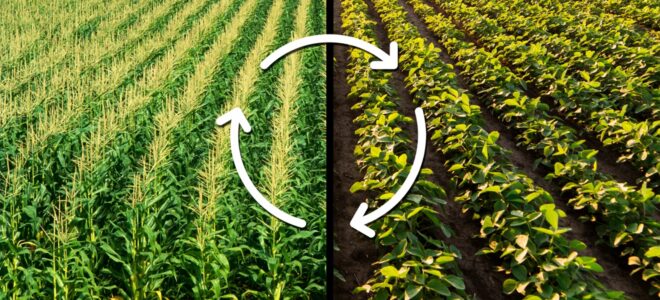Crop rotation is a time-honored agricultural practice that has stood the test of time, proving to be a cornerstone of sustainable farming. This article delves into the intricacies of crop rotation techniques, exploring their historical roots, benefits, and the modern approaches that contribute to the health of both soil and crops.

source:-usfarmersandranchers.org
Crop rotation, often hailed as the unsung hero of agriculture, involves the systematic sequencing of different crops in a specific order over consecutive growing seasons. This technique is not merely a tradition; it’s a science-backed strategy with far-reaching benefits for both farmers and the environment.
Historical Context
The roots of crop rotation can be traced back to ancient agricultural societies that intuitively grasped the importance of diversifying their plantings. Over time, this practice evolved, with documented instances dating back to the Roman Empire and medieval Europe.
Benefits of Crop Rotation
Improved Soil Fertility
Crop rotation plays a pivotal role in maintaining and enhancing soil fertility. By alternating crops with different nutrient needs, the soil is replenished with essential elements, mitigating the risk of depletion.
Pest and Disease Management
One of the primary advantages of crop rotation is its efficacy in pest and disease control. Disrupting the life cycles of pests and pathogens helps farmers reduce the need for chemical interventions, fostering a healthier ecosystem.
Enhanced Crop Yield
The overall crop yield sees a significant boost due to the balanced nutrient levels, reduced pest pressure, and improved soil structure. Farmers practicing crop rotation often witness a more robust and diverse harvest.
Crop Rotation Techniques
Sequential Cropping

source:-prep.in/news
Sequential cropping involves cultivating different crops in sequential seasons on the same piece of land. This strategic arrangement helps break pest and disease cycles and optimizes nutrient utilization.
Cover Cropping
Cover crops, such as legumes and clover, are planted between main crops to protect and enrich the soil during the off-season. They act as green manure, contributing organic matter and nitrogen to the soil.
Relay Cropping
Relay cropping is a technique where a second crop is sown before the first is harvested. This overlapping ensures continuous ground cover, reducing soil erosion and maximizing resource use.
Planning Your Crop Rotation
Understanding Crop Families
Crops belong to specific families with similar nutrient needs and susceptibilities. Understanding these relationships is crucial for effective planning and execution of crop rotation.
Designing a Rotation Schedule
A well-thought-out rotation schedule considers factors such as crop growth habits, soil requirements, and market demand. This planning ensures a balanced and sustainable farming system.
Impact on Soil Health
Soil Structure Improvement
Crop rotation contributes to better soil structure by promoting the growth of different root structures. This diversity enhances water retention, drainage, and overall soil tilth.
Nutrient Balance and Pest Managment
The alternation of crops with varying nutrient demands prevents soil exhaustion. Additionally, the incorporation of organic matter through cover crops enhances nutrient levels, fostering a nutrient-rich environment.
Disrupting Pest Life Cycles
Pests often specialize in specific crops. Crop rotation disrupts their life cycles, making it challenging for pests to establish and proliferate, reducing the need for chemical interventions.
Suppressing Soil-Borne Diseases
Certain crops are prone to soil-borne diseases. Crop rotation breaks the disease cycle by introducing non-host crops, effectively managing and suppressing soil-borne pathogens.
Sustainable Agriculture Practices
Role of Crop Rotation in Sustainable Farming
As the world embraces sustainable agriculture, crop rotation emerges as a linchpin practice. Its inherent ability to conserve resources, reduce environmental impact, and enhance long-term productivity aligns seamlessly with sustainability goals.
Environmental Benefits
The environmental advantages of crop rotation are manifold. It minimizes the need for synthetic fertilizers and pesticides, curbing potential water pollution and promoting biodiversity in agroecosystems.
Challenges and Considerations
Potential Drawbacks of Crop Rotation
While crop rotation offers numerous benefits, challenges exist. These include the need for careful planning, potential yield fluctuations, and the adaptation of machinery and equipment to varied crops.
Mitigating Challenges
Farmers can overcome challenges through meticulous planning, soil testing, and adapting to new technologies. Continuous education and knowledge exchange within farming communities also play a pivotal role in overcoming hurdles.
Real-life Examples
Success Stories of Farmers Implementing Crop Rotation
Across the globe, farmers have reaped the rewards of adopting crop rotation. Case studies from different regions highlight success stories where yields have increased, and soil health has been rejuvenated.
Lessons Learned from Diverse Agricultural Settings
Diverse climates and terrains require tailored approaches to crop rotation. Lessons learned from varied agricultural settings contribute to a collective understanding of best practices and innovation.
Technological Advancements Aiding Crop Rotation
In the contemporary era, technology plays a crucial role in optimizing crop rotation. Precision agriculture, data analytics, and smart farming techniques contribute to more efficient and effective crop rotation strategies.
Precision Agriculture and Smart Farming
Precision agriculture leverages technology such as GPS, sensors, and automated machinery to precisely manage crops, optimize resource use, and enhance the efficacy of crop rotation.
Cost-Effectiveness of Crop Rotation
While initial implementation may require adjustments, the long-term economic benefits of crop rotation far outweigh the costs. Enhanced yields, reduced input costs, and soil health contribute to sustained profitability.
Long-Term Economic Benefits for Farmers
Farmers practicing crop rotation experience increased resilience










